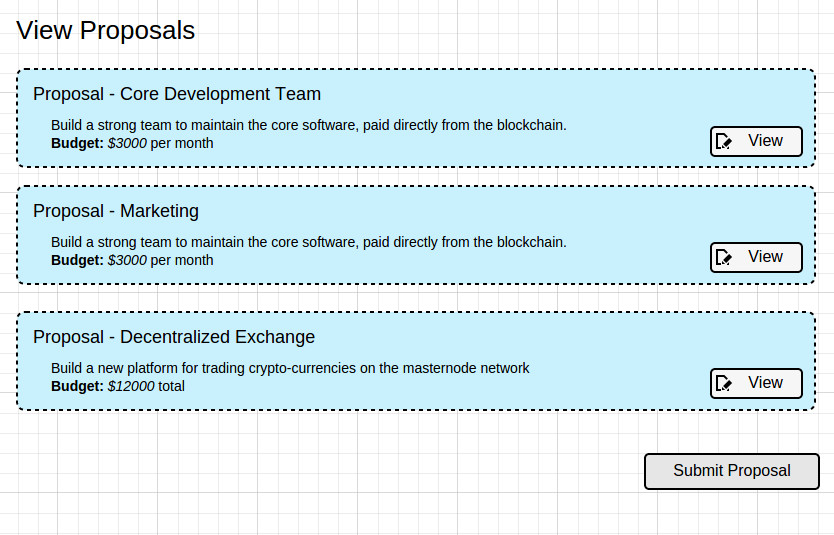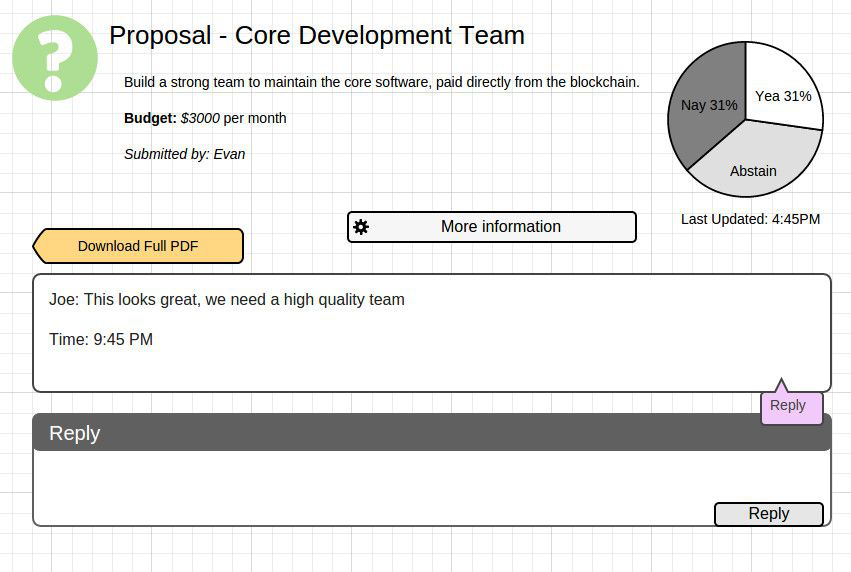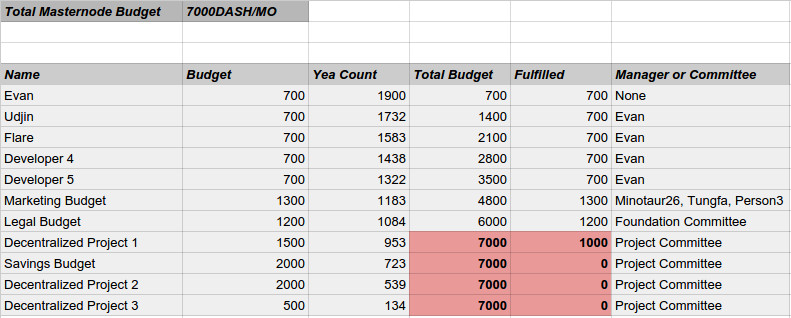Understanding the Governance and Budget System
Contents
Introduction
One of the greatest challenges of building a crypto currency platform is ensuring you create a decentralized system of governance to manage, fund, maintain and expand the project. This key element is absent in every currency to date, the natural response is to create a not-for-profit foundation that is tasked with maintaining the core protocol and promoting the coin but is not really connected to the coin holders in any meaningful way. This approach has a few issues that have been made evident from the experience of older crypto currency platforms.
Current crypto foundations are not related to the currency itself by any mechanism that is included in the protocol and are not designed to outlive early adopters when they lose interest. The foundation then struggles to get funding until it implodes and core development of the protocol is left scrambling for funding or depending on charity that can’t be counted on and does not allow for proper budgeting and planning. Donations are also unfair to donors because there are always free riders that benefit from the effort done by others without contributing. Other projects have financed themselves premining coins or doing pre launch sales, which is not a great solution either because control of the funds is centralized and at that stage it is impossible to quantify the future needs of the project.
Through the network of full nodes and the collateral requirement, Terracoin already counts with a decentralized network of masternode operators that are invested in the future of the currency and that as a group can act as stewards of the core protocol development and promotion. We propose a decentralized management system based on the masternode voting mechanism. Masternode operators are not the only ones interested in the success of Terracoin, but they are the most stable ones because, unlike miners, they can’t reuse their asset for any other purpose or coin.
A portion of the block reward is be held in escrow by the network itself, in the name of the operators, to be executed in the development and expansion of the ecosystem through the vote of the masternodes in different budget proposals. These funds are directed to supporting development and promotion of the coin, masternode operators would vote on specific budgets and projects to be funded, thus defining the direction the coin is taking. This is done in a completely transparent way where there is a public portal where new initiatives are proposed and masternodes can vote on them. Something like a decentralized kickstarter or Lighthouse, that can be used for anything that creates value within the ecosystem.
This is a 100% decentralized system powered by the masternodes, where budgets are set and paid directly from the blockchain. The blockchain could hire core developers this way and introduce a new concept of paid blockchain contractors, where people work for and are directly compensated by the network, through the decentralized votes of all masternode operators. One advantage of this model is it can survive early adopters. If early masternode operators sell their coins, the new owner can set up a masternode and with it acquire the right to vote on the budgets and projects. This guarantees there is a working system of maintenance as people come and go, making the network capable of sustaining itself on its own without depending on specific actors.
Masternode Voting And Setting Budgets
The system works as a decentralized voting mechanism set up in the software, where budgets for specific projects are proposed, then the masternodes as a whole vote on them. Each project, if it passes, is added to the total budget and paid directly from the blockchain to the person doing the work. With this, we can hire core developers and pay them directly after approval of the work in a decentralized fashion.
A masternode would vote using the command “masternode vote yay” or “masternode vote nay”, votes would then propagate across the network, would be tallied then the instructions followed by the network itself. Budgets being discussed could be seen by using the command “masternode budget show”.
A well defined decentralized system of governance will allow a crypto-currency network to endure and survive its original creators. Later generations of masternode operators would have a clear way to support the system that is defined by the protocol applying wisdom of the crowd techniques and the bond of trust established by the masternode collateral to create a decentralized management system.
This would create incredible value within the currency, allow us to be more agile and compete with other payment systems like Bitcoin and credit cards on a global scale.
After a period of time, we should have a strong team of productive paid contractors paid from the blockchain rewards. This should create a lot of value for us as we should have a very stable network, with faster implementation of core services that will make Terracoin successful.
Reward Schedule
To guarantee the long term sustainability of the blockchain, the network keeps a portion of the block rewards in escrow and the masternode operators would be tasked to act as stewards and invest in the maintenance and expansion of the network. This will result in faster development and promotion, creating a virtuous cycle that benefits all actors, including miners, masternode operators, investors and users. More importantly, this gives the blockchain itself a self-preservation mechanism that is beyond the control of any individual.
| 45% | Mining Reward |
| 45% | Masternode Reward for Proof-of-service |
| 10% | Decentralized Governance Budget |
Masternodes make 45% of the mining reward, miners also receive 45%. The remaining 10% is disbursed monthly by the masternode operators, creating the first self-sustainable decentralized cryptocurrency platform.
The masternode operators establish a social contract with the network they benefit from and are bound to act as caretakers, dedicating a portion of the network rewards to furthering the ecosystem. This has a ripple effect that benefits all parties involved especially the end users.
The value from the projects is expected to be much greater for everyone as this would benefit not only operators but also miners and users. This is different from the miners contribution to the ecosystem. Because miners don’t keep 100% of the block reward, like it happens in other PoW cryptocurrencies, we have masternodes and a much healthier network that increases the value of the reward that miners perceive. Besides that, masternodes will be able to vote on the introduction of this change, making the first distributed decision the actual creation of the system, similar to establishing a Constitution. This approach of distributing the normal block reward in a way that considers all critical elements a crypto-currency needs for its long term viability, e.g. mining, full nodes, development and promotion, is really revolutionary as it is done without changing the emission or creating any additional inflation for investors. The network just distributes the available resources in a way that is beneficial to everyone and it has already proven to be successful with the introduction of paid full node operations(masternodes).
Blockchain Contractors and Proposals
Contractors of the blockchain can be developers, outreach professionals, team leaders, attorneys or even people appointed to do specific tasks. We’ll have a website where masternode operators can stay up-to-date on what proposals need to be reviewed. Proposals will be considered, then ordered by the amount of ‘yea’s tallied. Proposals will be added in order of the yea count, then when the total budget is met, leftover pending proposals will not be added to the budget.
Proposal Website - Mockups
A website is available to show current proposals, so that the community can judge which ones are best and proposal submitters can iterate their designs to attempt to improve support.
Each proposal will have an attached PDF that details the project and what the goals are. There will also be a forum-like thread where the project can be discussed and details worked out with the community. At any time, the masternodes can vote to show how they feel about specific proposals. After each vote, the software will automatically tally the total votes and if the project gets the green light, allocate the budgets instantly if needed.
Proposals will have pages on a website that show their ongoing support from the masternode network. The masternodes will vote in a non-final way using the network, which this website will read then update statistics (the above pie chart). The proposals authors can update the PDF and have conversations via the comments to flush out their ideas with the community. This will be a process that occurs naturally to gain enough support to get the project funded.
The budget will be calculated in real time after a masternode updates their vote. This means if a proposal didn’t work as expected and was already approved, masternode operators could change their vote and remove funding immediately.
The total budget of the network can be calculated by taking 10% of the reward. The entire budget of the network will be allocated to be spent on the ecosystem. This will be done by voting on all of the proposals, then sorting them by approval rating like the image above. Each line item will then be added to the budget, until the total budget is used. Budgets would be calculated by the network itself in a completely trustless way.
It’s also worth noting, if it comes out that someone is misusing funds from an approved budget, masternode operators will change their votes to “nay”. The protocol calculates the winning budgets in real time, so the badly used budget could be removed within the space of a few hours. This is a completely reactive and trustless system.
Due to the decentralized nature of the masternode system, it might be necessary to make funded committees, that are responsible for some project or task. These would be submitted in the same way, but the committee itself would receive the funds. In projects like this, the committee would transparently report on what it spent money on and keep track of the progress of it’s projects.
If there is money left over in the budget, the system will also support proposals for moving money into a “savings” account managed by a group of people. This will allow us to plan for the future and budget for larger things or to stop the system from outright wasting money. There are no limitations on which groups do things, so other foundations could also be funded, that have separate or conflicting missions. This should allow a completely decentralized funding environment to form that is fault tolerant by it’s nature, where the network itself is looking out for its best interests through the knowledge of the crowd of the masternodes.
Managers, Committees and Fiat Payments
Some oversight will be needed for the blockchain contractors. Each budgeted item will require either a team manager or a committee. Periodically the managers will write what the person being paid is working on and show the value created from the funds that were allocated.
There are also cases where exact USD amounts must be paid (such as lawyers, etc). These cases will be managed by committees, where a group of people oversee a project. The group will have a multi-sig wallet that is paid from the blockchain, then they will make payments from that multi-sig for the exact amount needed. Committees will be required to be completely transparent and post updates about the progress they’re making and where the money is going.
In the case where a committee isn’t being transparent or is not posting updates, the community will begin to inquire about the status of the project. If no satisfactory answer is given, support will be lost, masternodes will change their vote and the project will drop off of the budget. In a way this system should be self policing.
Scaling and future uses
Eventually we’ll have many blockchain contractors. At this point team leaders would be elected as blockchain contractors to manage larger decentralized projects in the department depending on their current needs.
The project would put the power of determining where Terracoin goes in the future to the Masternode network itself. Later in the future, I see most of the core development and other projects that we didn’t even think of funded through this model. The ecosystem should be stable and growing without our help at all. That is the idea, that the blockchain could support itself regardless of the specific people involved even decades from now, is a decentralized management system built to outlive its original users, a self sustainable decentralized cryptocurrency network that can still operate cohesively and bring added value services to end users in a consistent way. This model could be really innovative and allow crowd funded peer to peer efforts to compete on a global scale with projects that are very well funded.
Conclusion
Every masternode operator establishes a bond of trust and a social contract with the network in which he is bound to contribute to the development and maintenance of the ecosystem he benefits from. Under this model, a portion of the funds that the operator is bound to receive are given to him in custody, not in ownership, and are held in escrow by the network to be executed by the operators for the benefit of the ecosystem. Everyone contributes equally and proportionately to the benefits they are receiving and the risks they are taking, there are no privileges and no loop-holes. This is complemented by the full node voting mechanism that allows for a distributed group to vote on a continuous basis on practical matters without the need to forfeit their right to decide to others, every few years, like with traditional governments or cooperative corporations.
We envision a future in which this model of transparent, unbreakable and verifiable contribution to the common good, in combination with continuous participation of the crowd through active voting, is utilized to manage organizations that are owned or ran jointly by its members, who share the benefits and responsibilities of those collectives, like governments, cooperative corporations, unions, DAOs, crypto-currencies, etc. We are calling this model, decentralized governance by blockchain.



